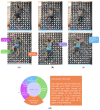Climbing Technique Evaluation by Means of Skeleton Video Stream Analysis
- PMID: 37837046
- PMCID: PMC10574944
- DOI: 10.3390/s23198216
Climbing Technique Evaluation by Means of Skeleton Video Stream Analysis
Abstract
Due to the growing interest in climbing, increasing importance has been given to research in the field of non-invasive, camera-based motion analysis. While existing work uses invasive technologies such as wearables or modified walls and holds, or focuses on competitive sports, we for the first time present a system that uses video analysis to automatically recognize six movement errors that are typical for novices with limited climbing experience. Climbing a complete route consists of three repetitive climbing phases. Therefore, a characteristic joint arrangement may be detected as an error in a specific climbing phase, while this exact arrangement may not considered to be an error in another climbing phase. That is why we introduced a finite state machine to determine the current phase and to check for errors that commonly occur in the current phase. The transition between the phases depends on which joints are being used. To capture joint movements, we use a fourth-generation iPad Pro with LiDAR to record climbing sequences in which we convert the climber's 2-D skeleton provided by the Vision framework from Apple into 3-D joints using the LiDAR depth information. Thereupon, we introduced a method that derives whether a joint moves or not, determining the current phase. Finally, the 3-D joints are analyzed with respect to defined characteristic joint arrangements to identify possible motion errors. To present the feedback to the climber, we imitate a virtual mentor by realizing an application on the iPad that creates an analysis immediately after the climber has finished the route by pointing out the detected errors and by giving suggestions for improvement. Quantitative tests with three experienced climbers that were able to climb reference routes without any errors and intentionally with errors resulted in precision-recall curves evaluating the error detection performance. The results demonstrate that while the number of false positives is still in an acceptable range, the number of detected errors is sufficient to provide climbing novices with adequate suggestions for improvement. Moreover, our study reveals limitations that mainly originate from incorrect joint localizations caused by the LiDAR sensor range. With human pose estimation becoming increasingly reliable and with the advance of sensor capabilities, these limitations will have a decreasing impact on our system performance.
Keywords: climbing motion analysis; human pose estimation; key point detection; sports and computer science; video analysis.
Conflict of interest statement
The authors declare no conflict of interest.
Figures









Similar articles
-
On-Sight and Red-Point Climbing: Changes in Performance and Route-Finding Ability in Male Advanced Climbers.Front Psychol. 2020 May 28;11:902. doi: 10.3389/fpsyg.2020.00902. eCollection 2020. Front Psychol. 2020. PMID: 32547440 Free PMC article.
-
Dynamics of Experience in a Learning Protocol: A Case Study in Climbing.Front Psychol. 2020 Feb 20;11:249. doi: 10.3389/fpsyg.2020.00249. eCollection 2020. Front Psychol. 2020. PMID: 32153467 Free PMC article.
-
Influence of On-Sight and Flash Climbing Styles on Advanced Climbers' Route Completion for Bouldering.Int J Environ Res Public Health. 2021 Nov 29;18(23):12594. doi: 10.3390/ijerph182312594. Int J Environ Res Public Health. 2021. PMID: 34886320 Free PMC article.
-
Performance indicators in speed climbing: insights from the literature supplemented by a video analysis and expert interviews.Front Sports Act Living. 2023 Dec 22;5:1304403. doi: 10.3389/fspor.2023.1304403. eCollection 2023. Front Sports Act Living. 2023. PMID: 38186397 Free PMC article. Review.
-
Wearable and Non-Invasive Sensors for Rock Climbing Applications: Science-Based Training and Performance Optimization.Sensors (Basel). 2023 May 25;23(11):5080. doi: 10.3390/s23115080. Sensors (Basel). 2023. PMID: 37299807 Free PMC article. Review.
Cited by
-
Detection of Lowering in Sport Climbing Using Orientation-Based Sensor-Enhanced Quickdraws: A Preliminary Investigation.Sensors (Basel). 2024 Jul 15;24(14):4576. doi: 10.3390/s24144576. Sensors (Basel). 2024. PMID: 39065974 Free PMC article.
-
Morphology of male world cup and elite bouldering athletes.Front Sports Act Living. 2025 Jun 11;7:1588414. doi: 10.3389/fspor.2025.1588414. eCollection 2025. Front Sports Act Living. 2025. PMID: 40575465 Free PMC article.
-
Towards Automatic Object Detection and Activity Recognition in Indoor Climbing.Sensors (Basel). 2024 Oct 8;24(19):6479. doi: 10.3390/s24196479. Sensors (Basel). 2024. PMID: 39409520 Free PMC article.
-
Deep learning-based human body pose estimation in providing feedback for physical movement: A review.Heliyon. 2024 Aug 26;10(17):e36589. doi: 10.1016/j.heliyon.2024.e36589. eCollection 2024 Sep 15. Heliyon. 2024. PMID: 39281455 Free PMC article. Review.
References
-
- Ekaireb S., Ali Khan M., Pathuri P., Haresh Bhatia P., Sharma R., Manjunath-Murkal N. Computer Vision Based Indoor Rock Climbing Analysis. 2022. [(accessed on 25 April 2012)]. Available online: https://kastner.ucsd.edu/ryan/wp-content/uploads/sites/5/2022/06/admin/r....
-
- Winter S. Klettern & Bouldern: Kletter- und Sicherungstechnik für Einsteiger. Rother Bergverlag; Bavaria, Germany: 2012. pp. 90–91.
-
- Apple Inc. Vision Framework—Apply Computer Vision Algorithms to Perform a Variety of Tasks on Input Images and Video. 2023. [(accessed on 25 April 2012)]. Available online: https://developer.apple.com/documentation/vision.
Grants and funding
LinkOut - more resources
Full Text Sources

